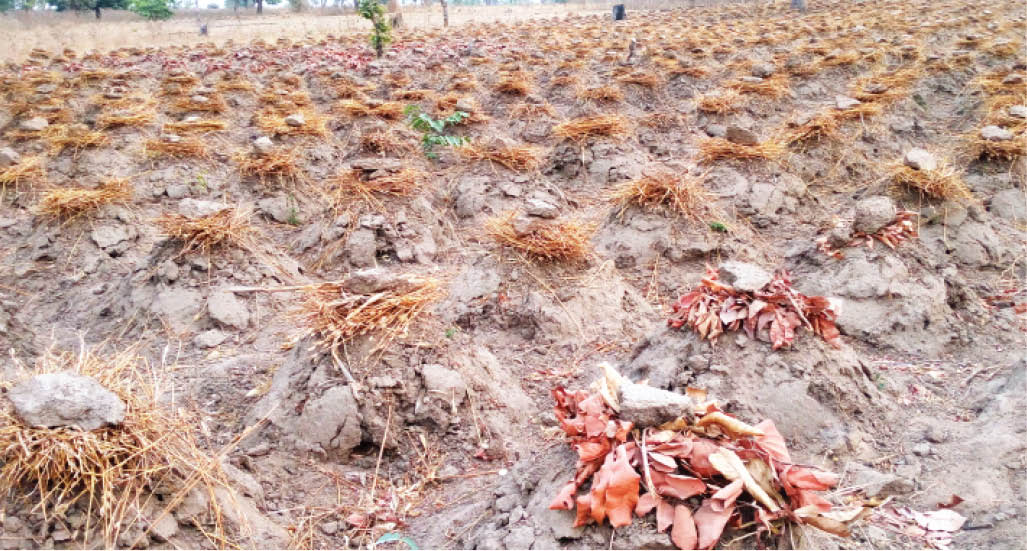Yam farmers are yet to embrace new methods of growing yam vine in smaller spaces for bigger harvest instead of the manual way of cultivating the tubers or millicent in larger farms.
Our correspondent reports that science in recent times has adopted the vine system which enables farmers to plant yam stems, for rapid production of high-quality yam that could earn farmers better income.
Chairman of Yam Farmers Association in Benue State, Mrs Scholarstica Amua, said yam seed production had evolved technologically such that there was no longer a need for the use of seedlings but the planting of yam vine (stems).
“We are yet to teach farmers the new method in Benue,” she said, but that arrangements are underway to sensitise them and other stakeholders on the need to embrace the new system for improved income as well as other benefits.
Similarly, a Seed Systems Principal Investigator at the Federal University of Agriculture, Makurdi (FUAM), Teryima Iorlamen, maintained that science is gradually moving farmers to soon start planting yam stems like they do in cultivating sweet potatoes.
He, in dissecting best agronomy practices which can help farmers grow healthy and bigger yams for consumption as well as increased income, harped on proper land preparation and need for farmers to wait until the rains stabilised before planting.
“As a root crop, the farmer needs to prepare the land very well to enable root penetration. Since yam is a root crop, at a point, it wouldn’t want much water and that’s why timing is very important.
“We insist that the soil should be the one that is well-drained so that at a particular point, the plant would be looking for more water, thereby, expanding and it would also cause the elongation of the roots and tubers. The soil also needs to be softened to aid the penetration for the crop.
“Some people plant their yam during the dry season, which is between January and March. However, the farmer who is planting at such period should be conscious of the sun. Because the temperature would be high, one of the recommended agronomy activities is that the farmer must mulch, meaning that he gets material and puts on-top of the heaps and also put sand so as to reduce the level of intensity of the sun on the yam heap.
“That should be done properly, otherwise, it would lead to the decay of the yam seedlings. Another reason why people plant at this time is because they feel it will encourage decay of yam material so that once rain stabilises, it would continue growth and development,” he explained.
Iorlamen nevertheless advised farmers to plant as soon as the rain stabilises,, stressing that, “sometimes, even when the first rain comes, the heat in the soil is much but when the rain stabilises, the temperature is favourable and the moisture content is enough for the crop to germinate.”
The seed specialist noted further that the more yam put into the soil, the bigger the tuber as he emphasised, “the more you give to the soil, the more you receive as far as yam is concerned. So we encourage those going into tuber production, as some are going into seedlings while others are interested in the tuber, to plant bigger sizes.
“But where the farmer only wants to multiply seeds or a particular variety, there would be no need for bigger tubers but go into what we call, yam millicent. Millicent is a technology that if you have tuber of yam that you are interested in multiplying; you slice it into smaller pieces and then prepare it and plant it.
“When you slice a yam, agronomically, we believe you are wounding that yam so you need to protect it with something like wood-ash to allow it clot which prevents the seed from micro-organism. There are some other treatment methods too which can be used to treat the sliced yams.”
On her part, the chairman of yam farmers, Amua, told our correspondent in Makurdi that there were two categories of yam farmers in the state; those who plant their yam seeds in September and those who do so in April when the soil is soft enough.
Amua said for convenience, she planted her seeds in September 2019, because leaving them in her warehouse meant wastage as they may likely get rotten before the commencement of rains.
She, however, said many other farmers prepared their heaps in September, to have time for other activities, but plant their crop in March, adding that each of the two seasons would achieve result only if best agronomy practices were taken into consideration, such as mulching.
Also, the state chairman of the All Farmers Association of Nigeria (AFAN), Comrade Aondongu Saaku, emphasised the need for those who plant in September to heavily mulch their heaps so that when the rain begins, the crop would germinate faster and not get rotten under intense heat.
Saaku said any of the two seasons of planting yam often yield the same result because the plants usually sprout at the same time, regardless of whether the farmer planted in September or April.
He pointed out that, “The crop grows at the same pace. It is only the methods that are different. We advise farmers to mulch their heaps even when they plant in April.”
The AFAN chairman also stressed the need for farmers to spray their farms at the right time, either at the planting in September or in April when the first rain starts and the grasses begin to sprout.
He added that preparation of land should begin as from October for those who make their heaps in December and wait until the rains before planting and that farmers should grow seeds for themselves instead of travelling far to get them.
“We get yam seeds from our farmers mostly. The farmers multiply the seeds themselves or get the variety they want from other farmers or markets. We have many varieties of yam in Benue. Researchers are trying on millicent but that is not widespread for now,” he said.
Saaku, who had a yam farm of 35,000 heaps in 2019, looks forward to cultivating 50,000 heaps this year as he waits for the early rains to commence the process.
“At the moment, we’re sensitising farmers in the state to grow their yam organically instead of using chemicals because we are now exporting our yams and don’t want it to be rejected in the market due to chemical residues,” he added.
The AFAN chairman, however, noted that weed control remained a challenge as they do not have the right chemicals for weeds control and also expressed worry that yam preparation was mostly done manually as there are still no tractors to make heaps concluding that “mechanisation of yam farming not yet effective.”
Interestingly, many of the farmers told our correspondent that they are waiting earnestly for the commencement of this year’s rainy season to plant their seedlings in their already prepared farm lands while some disclosed that they have already planted their seeds.
James Ejembi, a yam farmer in Otukpo area of the state, said his yam farm had been ready since December 2019, adding that he would not plant his seeds until mid-April this year as early planting may get the seedlings rotten from heat.
But Uloko Adah of the same locality, who had already cultivated his three hectares of yam farm, said he mulched the heaps so much that heat would not harm his seeds before the rains start.
Meanwhile, Iorlamen has advised farmers to make their choice of seeds from the varieties of yam in Benue, noting that yams have local names.
“We have white yam, water yam and so on. It now depends on the farmers choice and reason for production; it is the end users that tell us which variety to produce. The farmer also needs to check the size of varieties good for his farm, he needs to find out if the seeds are good for his soil and the sensibility of the variety to the soil.
“But interested farmers can always get good seeds and varieties from the Federal University of Agriculture in Makurdi and the College of Agriculture in Yandev because the institutions are involved in the production of some of these varieties. So also in any of the International Institute of Tropical Agriculture (IITA) stations closer to them,” the seed expert stated.

 Join Daily Trust WhatsApp Community For Quick Access To News and Happenings Around You.
Join Daily Trust WhatsApp Community For Quick Access To News and Happenings Around You.


